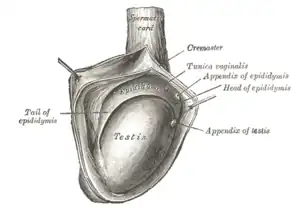Appendix of testis
| Appendix of testis | |
|---|---|
 The right testis, exposed by laying open the tunica vaginalis (appendix of testis is labeled at right) | |
| Details | |
| Precursor | Müllerian duct |
| Identifiers | |
| Latin | Appendix testis |
| TA98 | A09.3.02.010 |
| TA2 | 3612 |
| FMA | 19846 19846, 19846 |
| Anatomical terminology | |

The appendix testis (or hydatid of Morgagni) is a vestigial remnant of the Müllerian duct, present on the upper pole of the testis and attached to the tunica vaginalis. It is present about 90% of the time.
Clinical significance
Torsion
The appendix of testis can, occasionally, undergo torsion (i.e. become twisted), causing acute one-sided testicular pain and may require surgical excision to achieve relief. One third of patients present with a palpable "blue dot" discoloration on the scrotum. This is nearly diagnostic of this condition. If clinical suspicion is high for the serious differential diagnosis of testicular torsion, a surgical exploration of the scrotum is warranted. Torsion of the appendix of testis occurs at ages 0–15 years, with a mean at 10 years, which is similar to that of testicular torsion.[1]
See also
References
- ↑ Jason S Chang. "Torsion of the Appendices and Epididymis". Medscape. Updated: Oct 20, 2016. Citing:
Nason, Gregory J; Tareen, Farhan; McLoughlin, Danielle; McDowell, Dermot; Cianci, Fiona; Mortell, Alan (2013). "Scrotal exploration for acute scrotal pain: A 10-year experience in two tertiary referral paediatric units". Scandinavian Journal of Urology. 47 (5): 418–422. doi:10.3109/00365599.2012.752403. ISSN 2168-1805.
External links